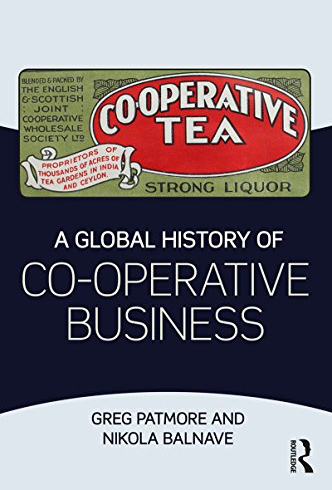A Global History of Co-operative Business, Greg Patmore and Nikola Balnave, (Routledge, 2018)
This valuable new history of the global co-operative movement charts its rise and its evolution – and crucially outlines the way it has been shaped by wider influences.
For instance, new forms of co-operation were born from the hardships of industrialisation in the 19th century, with the rise of the first retail co-ops; the ideals of the counterculture of the 1970s led to a proliferation of worker co-ops; and now a new movement, platform co-operativism, has arrived to meet the needs of those left adrift by the financial crash of 2018 and the growth of insecure work in the digital gig economy.
With this broader global and historical context, Greg Patmore (emeritus professor of business and labour history and chair of the Co-operatives Research Group at the University of Sydney) and Nikola Balnave (senior lecturer in the department of marketing and management and president of the Australian Society for the Study of Labour History) add welcome depth to a familiar story.

There’s a chapter surveying the precursors to the Rochdale Pioneers, looking at the influence of the UK’s Industrial Revolution and the political philosophies of the era on the rise of early co-ops, with 46 flour and bread societies formed between 1759 and 1820 to sell at below-market prices. It places such efforts alongside the co-operative ideas of social reformers like Robert Owen and Dr William King and the growth of linked movements such as Chartism and trade unionism. Meanwhile, early financial co-ops were appearing in the USA and worker co-ops were being formed in France, despite official restrictions on popular associations.
After the modern consumer co-op movement was birthed by the Rochdale Pioneers in 1844, it faced a series of problems related to capitalisation and supply chains – which would eventually see the rise of co-operative wholesaling. But a period economic growth saw improved wages and conditions for skilled workers, allowing them to supply the working capital needed by co-ops to proliferate and diversify. Again, Patmore and Belnave see this growth in the context of wider ideological developments, in particular the religious Redemption movement in the north of England and Christian Socialism in the south.
The book takes in the parallel stories of the rise of financial co-ops in Europe, with the rise of the Schulze-Delitzsch and Raiffeisen models; of interest in co-operative communities as new areas of the USA were settled and – just 15 years after the Rochdale Pioneers set up shop – Australia’s first consumer co-op. By 1861, Australia even had a short-lived coalminers’ co-op, created in the wake of a labour dispute.
From there, Patmore and Balnave chart the spread of the movement as it globalised and diversifiedin the years before the First World War, facilitated by faster world transport by sea and rail, increased migration levels and improvements in telecommunications. It’s a period which saw the movement square off against its enemies, with the CWS fighting legal battles against capitalist rival William Lever, and growing differences in style and outlook within the movement. The authors note party-political neutrality in British and Swiss consumer co-ops, in contrast with a socialist outlook in France and Belgium – and how, in 1902, different attitudes to social democracy split the German movement in two.
This was a crucial period in shaping the movement, with landmarks such as the foundation of the International Co-operative Alliance in 1895, but there were tough times ahead in the 20th century. The book shows how the movement would continue to be shaped by wider historical forces beyond its control – such as the Great Depression, the rise of totalitarian systems and World War II.
It’s a situation which has continued in the form of the postwar boom, and the financial crises which have followed it since the 1970s, through to the rise of neo-liberalism in the present day. There has also been a growing of internationalism in the movement which has seen the emphasis move away from Europe. Patmore and Balnave note the opening of African and Asian offices by the International Co-operative Alliance, and the growth of the US-based World Council of Credit Unions.
As they take us through these shifting eras, the authors provide vivid snapshots of key moments, such as clampdowns on worker organisations by statist Nazi and Soviet regimes; the spread of co-operativism to India and Africa via British colonialism; the birth of the Latin American credit union at the hands of a Catholic priest in Peru, in 1955; the rise of finance co-ops to serve prosperous blue-collar workers in the US’s post-war boom; and the crisis which tore through the Australian and New Zealand co-op movements in the late 1970s.
With this thorough overview of the co-operative story, the book shows how the movement has responded to challenges and opportunities in the past, not always successfully. It makes valuable reading for co-operators plotting a course through an ever-more turbulent world.

